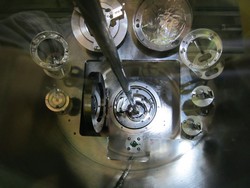Neutron and muon research in Europe receives a boost
The EU-funded project NMI3-II(opens in new window) (Neutron scattering and muon spectroscopy integrated initiative) extended the groundbreaking work of the earlier NMI3 project. In the NMI3 project, 18 partners, including all major providers of neutrons and muons in Europe, were brought together to open the way for more concerted and efficient use of their research facilities. Neutrons can be used to look inside any kind of material (e.g. a plant, an engine, a statue) without damaging it. NMI3-II was initiated to ensure that the scientific community will have access to their top-flight facilities until 2016. To facilitate implementation of the transnational access programme, partner institutes streamlined their procedures for proposal submission and review. The ultimate goal was to have a common entry point to apply for experiments in all European facilities. Nearly 2 000 scientists have received NMI3 support to use over 5 000 beamline days at the facilities. This generated over 210 publications (and counting) in peer-reviewed journals. Results shed light across the fields of chemistry, engineering, life, materials, ICT, earth & environment, humanities, energy, and physics. Joint research activities led to improvements on multiple fronts. The Tools for Soft & Bio Materials JRA developed new model membranes, which are much simpler than biological membranes, making it easier to investigate life’s processes; soft-material-specific sample environments that can withstand dynamic external stimuli, allowing the study of new processes; and in-situ devices. Scientists can now analyse materials at higher humidity, temperature, electric field, and pressure, addressing grand challenges in energy, environment, and health. The Advanced Methods & Techniques JRA investigated new instrument designs and sample environments to exploit the very high intensity neutron beams at the future neutron source, the European Spallation Source (ESS) - the most forward-looking research facilities being built in Europe today. The JRA provided the conditions to analyse very small samples in more extreme environments, and polarise all neutrons in a beam, which can be used e.g. to investigate magnetic materials. For many years neutron scattering facilities have depended on helium-3 for many of their detectors. The current penury in supply of 3He requires new technologies for cost effective, large area detectors. To tackle this problem, the Detectors JRA worked on two promising alternatives: scintillation detectors using 6Li, and gas detectors using 10B. These advances underpin new science. Neutron Imaging looks inside objects without damage. This JRA developed innovative methods to probe structures in bulk materials (e.g. a car engine). It is now possible to conduct experiments with better contrast and higher definition, and reconstruct 3D configurations of large arrays of nanostructures. This technique is used by experts from museums, materials science, and industry. The Muon JRA developed new algorithms, together with a link between analysis and simulation codes, which provided the user with improved methods for data analysis. Concept studies were performed for future muon sources centred on improved targets, advanced micro-beams and high intensity sources. NMI3-II conducted a comprehensive educational programme called NaMES, which addressed different fields of science to attract early-career scientists to neutron and muon science (roughly 1 500 students received training over the 4-year project duration). For those who could not attend the schools or needed to learn about neutron scattering at home or in the office, NMI3 developed the e-learning portal e-neutrons.org. Watch the project’s video(opens in new window) here.







